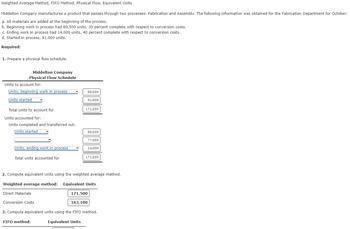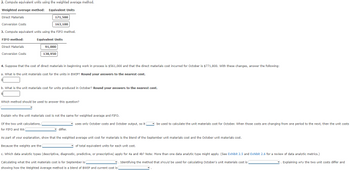Weighted Average Method, FIFO Method, Physical Flow, Equivalent Units Middelton Company manufactures a product that passes through two processes: Fabrication and Assembly. The following information was obtained for the Fabrication Department for October: All materials are added at the beginning of the process. Beginning work in process had 80,500 units, 30 percent complete with respect to conversion costs. Ending work in process had 14,000 units, 40 percent complete with respect to conversion costs. Started in process, 91,000 units. Required: 1. Prepare a physical flow schedule. Middelton Company Physical Flow Schedule Units to account for: Total units to account for Units accounted for: Units completed and transferred out: Total units accounted for 2. Compute equivalent units using the weighted average method. Weighted average method: Equivalent Units Direct Materials Conversion Costs 3. Compute equivalent units using the FIFO method. FIFO method: Equivalent Units Direct Materials Conversion Costs
Process Costing
Process costing is a sort of operation costing which is employed to determine the value of a product at each process or stage of producing process, applicable where goods produced from a series of continuous operations or procedure.
Job Costing
Job costing is adhesive costs of each and every job involved in the production processes. It is an accounting measure. It is a method which determines the cost of specific jobs, which are performed according to the consumer’s specifications. Job costing is possible only in businesses where the production is done as per the customer’s requirement. For example, some customers order to manufacture furniture as per their needs.
ABC Costing
Cost Accounting is a form of managerial accounting that helps the company in assessing the total variable cost so as to compute the cost of production. Cost accounting is generally used by the management so as to ensure better decision-making. In comparison to financial accounting, cost accounting has to follow a set standard ad can be used flexibly by the management as per their needs. The types of Cost Accounting include – Lean Accounting, Standard Costing, Marginal Costing and Activity Based Costing.
Weighted Average Method, FIFO Method, Physical Flow, Equivalent Units
Middelton Company manufactures a product that passes through two processes: Fabrication and Assembly. The following information was obtained for the Fabrication Department for October:
- All materials are added at the beginning of the process.
- Beginning work in process had 80,500 units, 30 percent complete with respect to conversion costs.
- Ending work in process had 14,000 units, 40 percent complete with respect to conversion costs.
- Started in process, 91,000 units.
Required:
1. Prepare a physical flow schedule.
| Units to account for: | |
|
|
|
|
|
|
| Total units to account for | |
| Units accounted for: | |
| Units completed and transferred out: | |
|
|
|
|
|
|
|
|
|
| Total units accounted for |
2. Compute equivalent units using the weighted average method.
| Weighted average method: | Equivalent Units |
| Direct Materials | |
| Conversion Costs |
3. Compute equivalent units using the FIFO method.
| FIFO method: | Equivalent Units |
| Direct Materials | |
| Conversion Costs |
4. Suppose that the cost of direct materials in beginning work in process is $561,000 and that the direct materials cost incurred for October is $771,800. With these changes, answer the following:
a. What is the unit materials cost for the units in BWIP? Round your answers to the nearest cent.
$
b. What is the unit materials cost for units produced in October? Round your answers to the nearest cent.
$
Which method should be used to answer this question?
Explain why the unit materials cost is not the same for weighted average and FIFO.
Of the two unit calculations, _____________ uses only October costs and October output, so it_______
be used to calculate the unit materials cost for October. When those costs are changing from one period to the next, then the unit costs for FIFO and WA ____________differ.
As part of your explanation, show that the weighted average unit cost for materials is the blend of the September unit materials cost and the October unit materials cost.
Because the weights are the_________ of total equivalent units for each unit cost.
c. Which data analytic types (descriptive, diagnostic, predictive, or prescriptive) apply for 4a and 4b? Note: More than one data analytic type might apply. (See Exhibit 2.5 and Exhibit 2.6 for a review of data analytic metrics.)
Calculating what the unit materials cost is for September is________ Identifying the method that should be used for calculating October's unit materials cost is_______
. Explaining why the two unit costs differ and showing how the Weighted Average method is a blend of BWIP and current cost is _________
.


Trending now
This is a popular solution!
Step by step
Solved in 3 steps

Qestion 2. Still needs to be solved. or Subpart #2.
2. Compute equivalent units using the weighted average method.
Attached is 2 screenshots of the entire question










